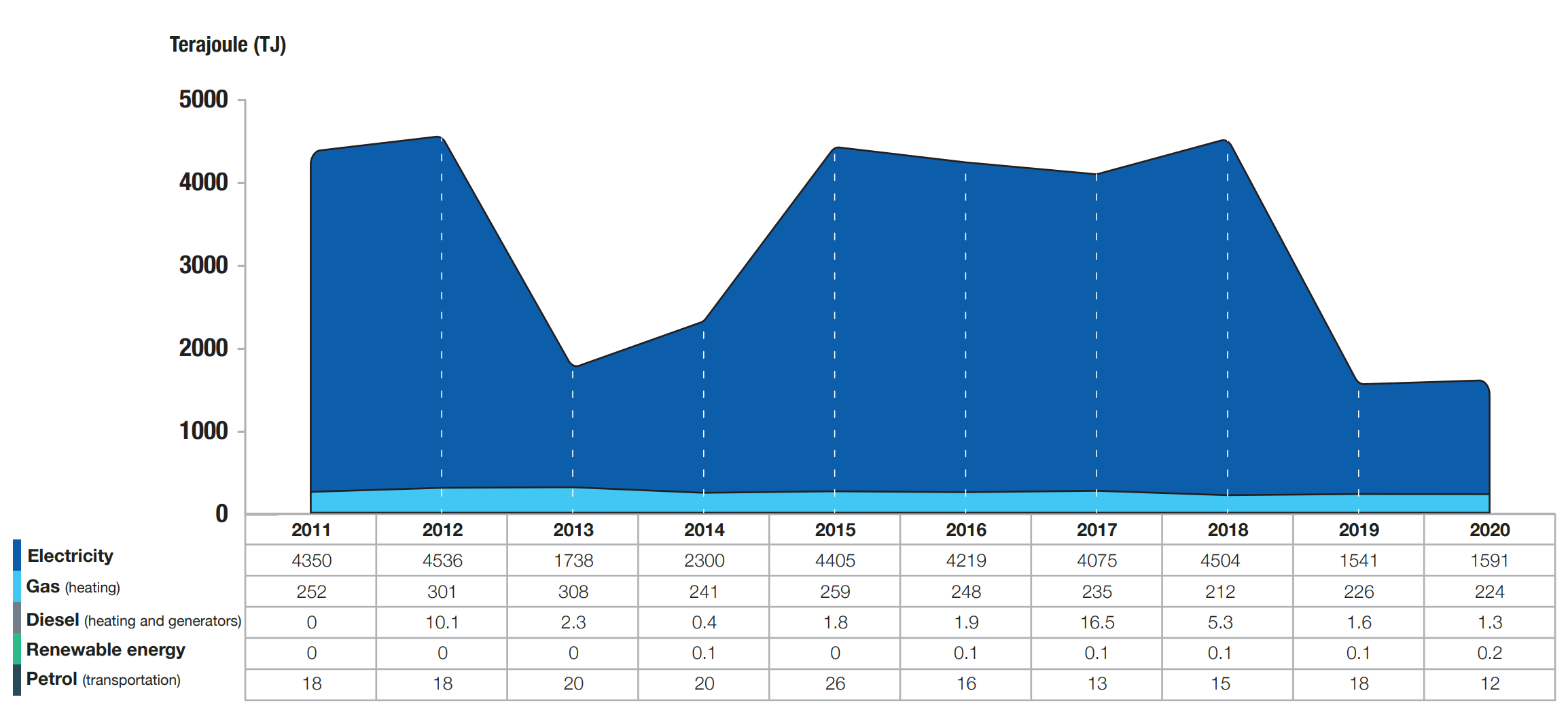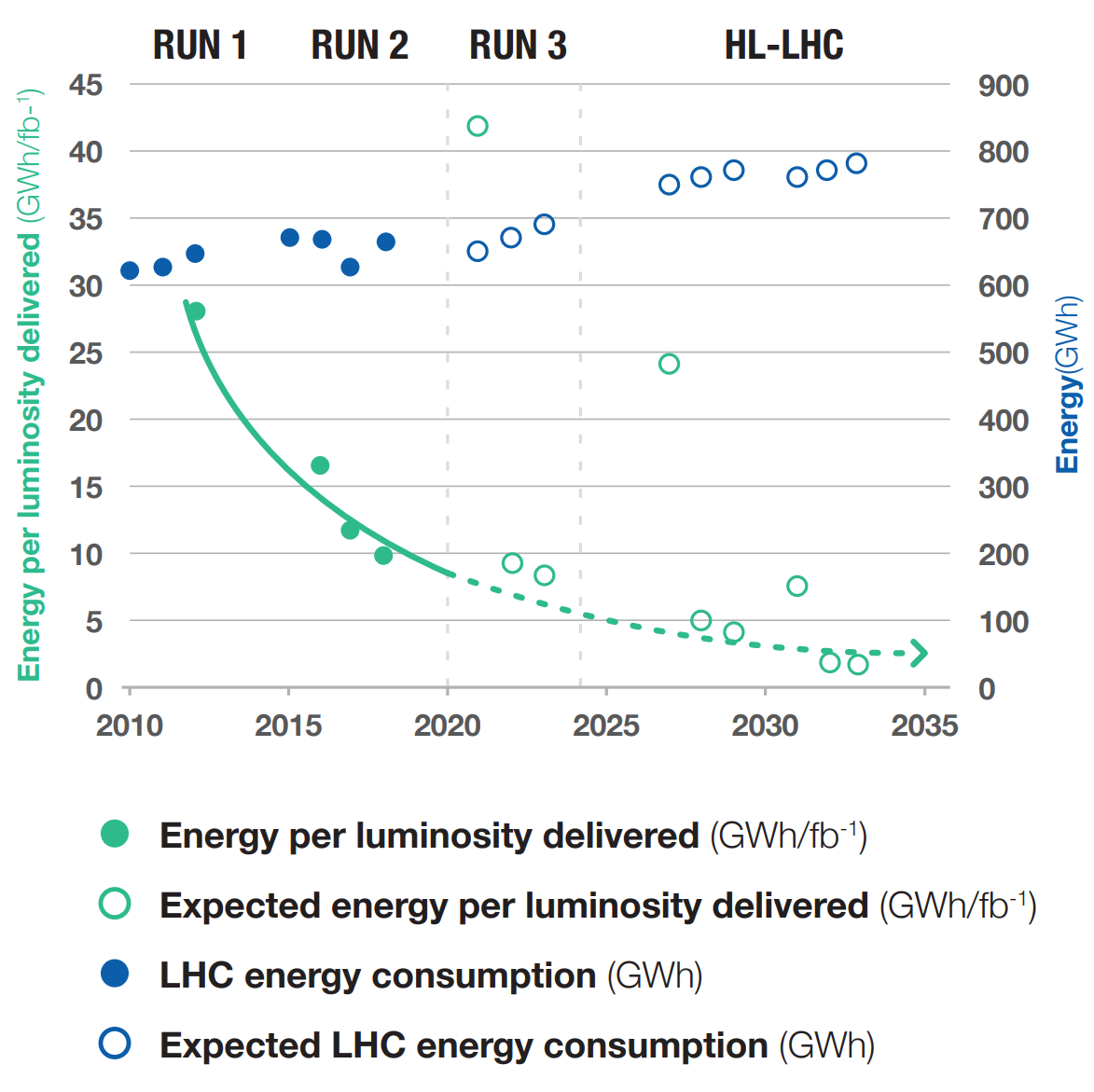At CERN, accelerators are responsible for most of the Laboratory’s energy consumption. As powerful research instruments, these machines make a unique scientific programme possible and support a global community of scientists. CERN makes every effort to run them in the most energy-efficient way possible.
Energy consumption
Electricity is the main source of energy used at CERN. It is mainly procured from France, whose energy grid mix is 87% low-carbon. In 2019 and 2020, CERN consumed 428 GWh (1541 TJ) and 442 GWh (1591 TJ) of electricity respectively. During this period, the LHC was in its second long shutdown (LS2), and CERN’s electricity consumption was about 64% lower than when the machine is running.
In addition to electricity, CERN also uses natural gas for heating, petrol for its fleet of vehicles and diesel for emergency generators. In 2019 and 2020, CERN consumed 68 GWh (246 TJ) and 66 GWh (238 TJ) of fossil fuels respectively. Energy procurement represents around 5% of CERN’s annual budget, with this percentage being lower during periods of shutdown.
The LHC experiments produce around 90 petabytes (90 x 1015 bytes) of data per year. An additional 25 petabytes of data are produced per year by non-LHC experiments. The data is stored, distributed and analysed by scientists around the world using the Worldwide LHC Computing Grid (WLCG). The WLCG is one of the world’s largest computing infrastructures, managed and operated by a worldwide collaboration between the LHC experiments and the participating computer centres. The WLCG’s energy consumption detailed here only relates to the facilities owned or operated by CERN. At the end of 2019, CERN ended its seven-year collaboration with the Wigner Data Centre in Hungary, which had been hosting a significant amount of computing equipment providing additional capacity to the CERN Data Centre. The Wigner Data Centre consumed 9.7 GWh (35 TJ) of energy in 2019.

Higher luminosity, higher performance

CERN’s main product is data produced by particle beam collisions and recorded by experiments. The Organization constantly strives to make its accelerators more energy efficient. The LHC is responsible for about 55% of CERN’s energy consumption during times of operation. In the coming years, the number of collisions produced by the LHC, denoted by a parameter known as luminosity, which is measured in units of inverse femtobarns (fb-1), will almost triple. Higher luminosity equates to more data for the experiments, giving them greater precision and more potential for new discoveries, but it usually comes at the cost of greater energy consumption.
CERN has developed a metric to illustrate the quantity of energy used per unit of luminosity delivered, expressed as Gigawatt hours per inverse femtobarn (GWh/fb-1). During Run 1 of the LHC, the best performance was 27 GWh/fb-1. As shown in the graphic, the LHC delivered twice as much data per unit of energy in Run 2 compared to Run 1. This ratio is expected to improve again for Run 3 and even further for the High-Luminosity LHC (HL-LHC). CERN anticipates the performance ratio at the start of HL-LHC running to be around 5 GWh/fb-1 and improve to 2.5 GWh/fb-1 later on. With respect to Run 1, the HL-LHC will increase the energy efficiency of CERN’s flagship facility by a factor of ten over 20 years.
Increase efficiency, use less, recover more
CERN is committed to limiting its increase in energy consumption to 5% up to the end of 2024 (baseline year: 2018). Longer-term objectives will be set in future reports. In order to do so, the Energy Management Panel (EMP) has deployed three main strategies for energy: increase efficiency, use less, and recover waste energy.
In managing the use of energy, the focus is on the accelerators and new projects, such as the HL-LHC. The Laboratory will also study the energy use during LS2 to evaluate what CERN could do to optimise energy consumption during these periods in the future.
Although energy used in buildings is only a small fraction of the Laboratory’s total energy consumption, all new buildings at CERN – such as Science Gateway, CERN’s new centre for science education and outreach – are designed to be energy efficient. When older buildings are renovated, it is done with energy efficiency in mind.
Since 2018, CERN has been carrying out a major renovation of the Proton Synchrotron’s East Area. The first phase of the project, which was completed in 2019, involved the restoration of the building’s envelope to improve energy efficiency. During the second phase, beamlines were renewed and old power converters were replaced with new ones designed to supply the magnets on a cyclical basis, with an energy-recovery stage between each cycle. With this renovation project, electricity consumption for the East Area is expected to fall from 11 GWh/year to around 0.6 GWh/year. During the first long shutdown, a similar powering scheme was introduced at the Super Proton Synchrotron (SPS) accelerator, which reduced the machine's energy consumption by 40 GWh/year.
In 2019, CERN signed an agreement with the local French authorities regarding the collection of heat from its facilities at Point 8 of the LHC to heat up a residential area in neighbouring Ferney-Voltaire (see In focus). CERN is continuing to explore heat recovery from its other sites, notably Point 1 in Meyrin, where heat could be recovered from cooling towers to provide central heating on the Meyrin site. In 2020, CERN awarded a contract for the design, construction, operation and maintenance of a new data centre, whose heat might be recovered to heat the Prévessin site.
In focus
Paul Pepinster, project leader in CERN’s Cooling and Ventilation group and technical coordinator of the Heat Recovery project.
— What is the Heat Recovery project?
PP: Hot water from the LHC cooling system will be diverted and used to heat up a new residential area in the town of Ferney-Voltaire. Thanks to this heat, the housing will be heated at lower cost and with reduced CO2 emissions. The quantity of heat delivered will be progressive over 8-10 years, reaching 20 GWh/year.
— When will it be finished?
PP: We have finished the construction of the heat recovery circuit up to the perimeter of CERN’s site at Point 8 of the LHC ring. To avoid disturbances to the accelerator, this work was completed during the second long shutdown. The local community is now preparing to lay 2 kilometres of pipes, while the accelerator is in operation. A plan to test the functionality of the system is scheduled for the end of 2022.
Learn more
Questions regarding this report may be addressed to environment.report@cern.ch.
